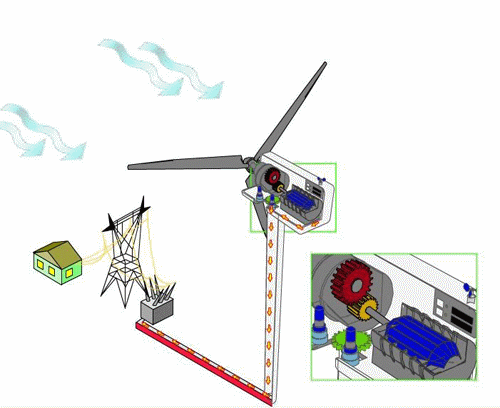Technology:
Scientific revolutions and technical dreams
Arnold Pacey, Chapter 10; Technology and World Civilization.
"The cheap generation of electric current opened the way to a much wider use of electricty in lighting, industry and transport. . . . "
One feature of these innovations was the highly organized research work on which they depended . . . . Chemistry was at the centre of a great many key development in nineteenth-century technology, because better understanding of the chemical nature of materials was so often critical."
p. 168.
"A different view emerges, though, if we take a broader view of technological development."
...small and large scale at the same time as part of industrial policy
"the good use made of local skills."
people skilled at older forms of technology initiating a 'technological dialogue' between western and traditional techniques.' This occurred particularly in silk and other textile industries....rapid experimentation in Iron...."
p. 181.
A social facet of existence that reorders behavior
Does it reorder reality?
Tow what extent does technological change result in social changes or socio-technical adaptive and exaptive shifts in order
| socio-technical | Tectonic | |||
|---|---|---|---|---|
| changes | adaptive | exaptive | ||
| Hand crafted | forged-iron making | stone, wood & metal | nutrition | iron casting molds – bells, canons – cylinders |
| Mechanical | clock & textiles | low-speed, moving gears | space | interchangeable parts – differential gears |
| Automated | steam locomotive | high-speed governors | time | reciprocating motion – refrigeration |
But do pre-adaptive social systems for the reorganiztion of work facilitate or block tectonic innovation?
Describe three examples:
1
2
3
Socio-technical change –fosters a widely shared myth of inevitable progress —beneath
which are clues quietly revealing how little we know about nature, our human character and social beliefs about automated tools.
markets | dreams | technical driver of modern automation | important lessons
“Chemistry was at
the center of a great many key developments in the 19th century technology,
because better understanding of the chemical nature of materials was often so
critical.”
pp. 168.
Innovations don’t have solely economic implications, for
example, inventors often desire to make the world a better, cleaner, and more
efficient place.
pp. 172-3.
markets | dreams | technical driver of modern automation | important lessons
Market fallacy
Technological change is Not market driven – that is “not”
created by economic demands.
To suggest that market considerations were at the core of
Rudolf Diesel’s thinking would be to misunderstand “creative thinking”.
Market forces are not the driving forces behind innovation,
but rather a dream that is a shared passion among investors and inventors
shapes what technologies –based on research are developed.
pp. 173.
“[Creative thinking] is the language of a man whose
imagination caught up with a dream, not merely a man who has merely recognized
a market opportunity”
pp. 173.
markets | dreams | technical driver of modern automation | important lessons
Dreams and inventions; Pacey's recurrent theme.
“The pursuit of technological ideals or dreams is readily
apparent in the innovations associated with Diesel, Lilienthal and Von Braun. Economic
advantage and military technology were not central in their motivation.”
pp. 175.
∙ Rudolf Diesel- created new engine in order to increase fuel efficiency
and cut costs.
∙ Werner Von Braun worked on creating V-2 rockets for the Nazis in WW
II, (they were used to destroy London) but after they were launched
successfully he was allowed by the US who captured him to switch his focus to
creating rockets for space travel.
∙ David Lilienthal furthered his knowledge of flight by creating designs
and hang gliders in order to pursue his dream of flight.
markets | dreams | technical driver of modern automation | important lessons
Cheap generation of electrical current opens the door for a much wider use of electricity
1. Widespread use of the light
bulb [the filament actually makes this a heat bulb].
2. Small electric tramway in
Berlin lead to urban cable cars & trolleys.
3. Small-scale power stations
providing city lights, run by a dynamo*
| How is technology so complex? | How is technological change important? |
markets | dreams | technical driver of modern automation | important lessons

Faith in progress reemerged in the electrical age.
progress; a state of development from a simpler to a more complex stage of formulation.
For technology to promote progress a technological imagination must --in addition to adaptive social organization and exaptation of materials-- promote diligent work characterized by follow-up, attention to details and anticipating why things break.
In short modern technology depends on smarter people and more imaginatively structured means of knowing how automated systems are more complex than we are able to think.
The new electrical vocabulary; a universal and fundamental force is electromagnetism.
dynamo –an electrical machine– or a device for converting mechanical energy into electrical energy by inducing an electrical current from between magnetic fields, called a generator.

previous chapter | Meaning | dimensions
markets | dreams | technical driver of modern automation | important lessons
 |
||
|---|---|---|
| Tools of Toil: what to read. | ||
| Tools are historical building blocks of technology. | ||

